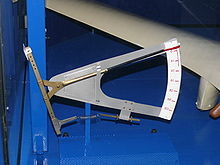Albert Octave Etévé
Albert Octave Etévé (born May 24, 1880 in Paris , † April 18, 1976 ) was a French aviation pioneer .
Etévé became interested in aviation early on. In 1906 he was assigned to the then Aérostation, where he in 1907 his license initially for free balloons and later for dirigible airships acquired. 1908. Capitaine ( Captain promoted), he was the Institute for Chalais-Meudon put where it access to the new engine flight got. After training on the first Wright biplane delivered to France for the army , he passed his examination and received the French pilot license No. 89 in February 1910. The weaknesses and inadequacies of the aircraft that were discovered arouse his technical talent. In the pursuit of more flight stability, he developed a flight stabilizer and in 1911 a baffle disc travel meter , which then became standard equipment for all French aircraft until the advent of anemometric flight measurement according to Raoul Badin .
Until 1914 he was director of the French military flight school in Versailles . His superior, General Pierre Auguste Roques , attested him to be an excellent officer as well as a remarkable pilot and an outstanding engineer. He then became head of the maintenance and repair service and was also charged with monitoring work at the manufacturing companies as far as series aircraft and prototypes were concerned. During this time he constructed a rotating mount for a defense machine gun, System Etévé, which was used by both the French and the Allied aircraft during the First World War. From 1916 to 1918 he was responsible for new developments. In 1925, when the engineering corps was founded, he was responsible for its growing together. Appointed Inspector General of the Air Force in 1935, he continued to strive to continuously improve his armament.
literature
- La victoire des cocardes l'aviation française avant et pendant la première guerre mondiale . Robert Laffont, Paris 1992, ISBN 2-221-02236-X (repr. Of the Paris 1970 edition)
| personal data | |
|---|---|
| SURNAME | Etévé, Albert Octave |
| BRIEF DESCRIPTION | French aviation pioneer |
| DATE OF BIRTH | May 24, 1880 |
| PLACE OF BIRTH | Paris |
| DATE OF DEATH | April 18, 1976 |
